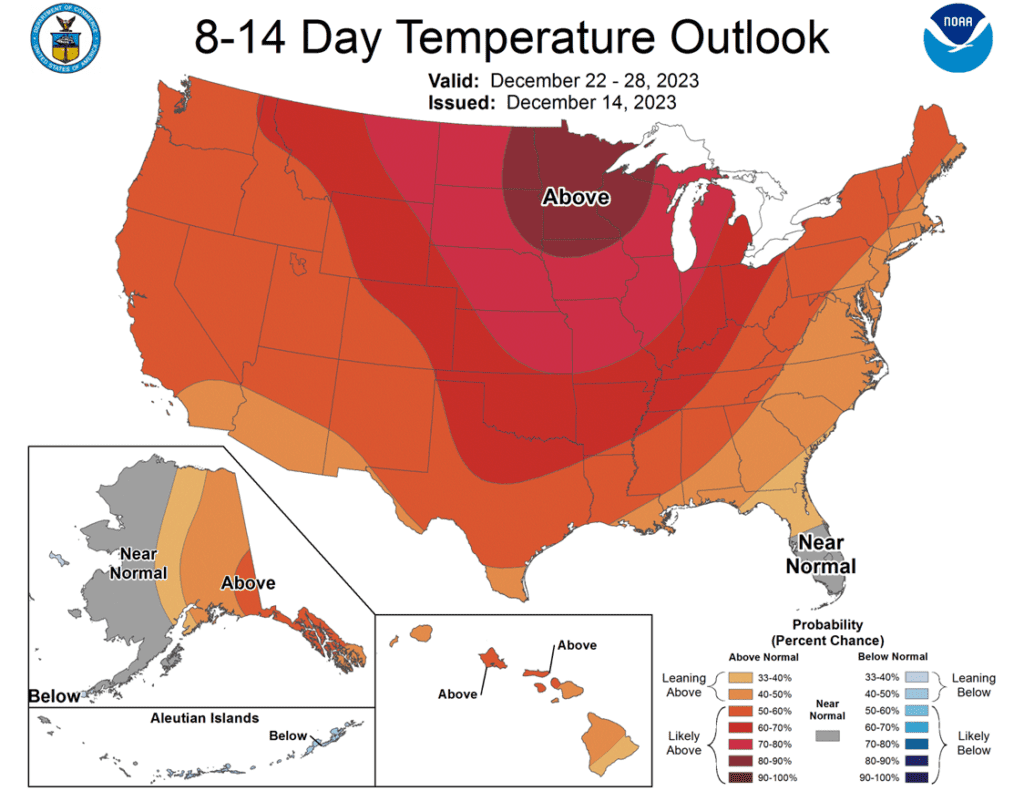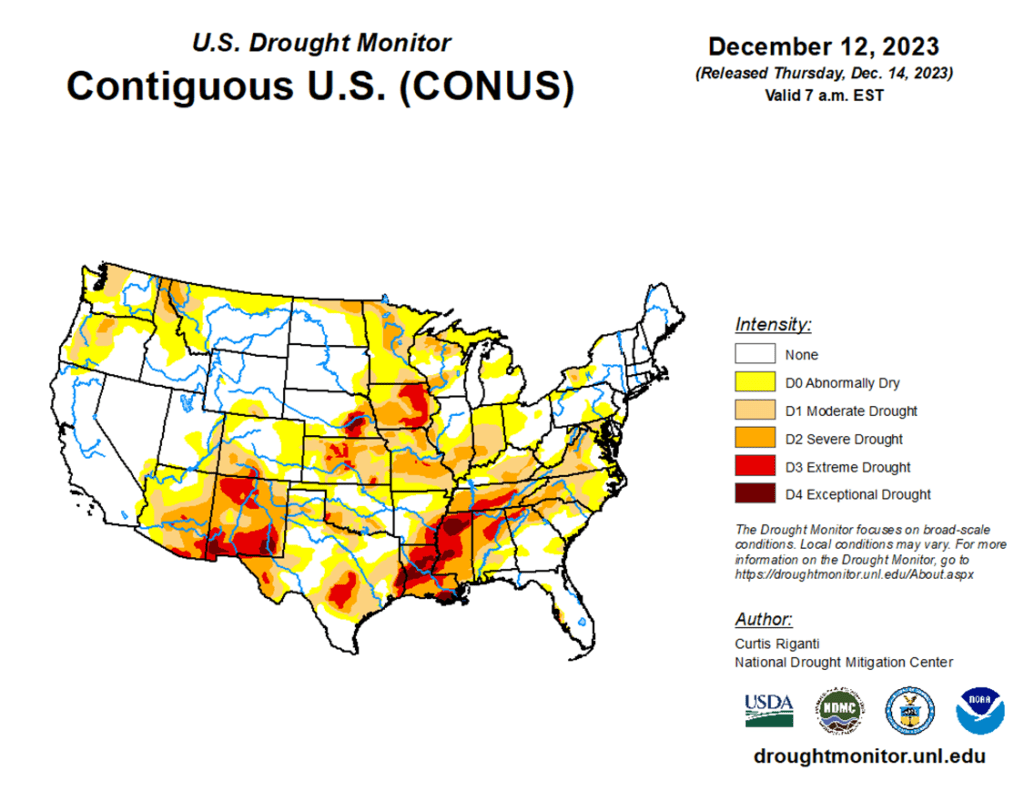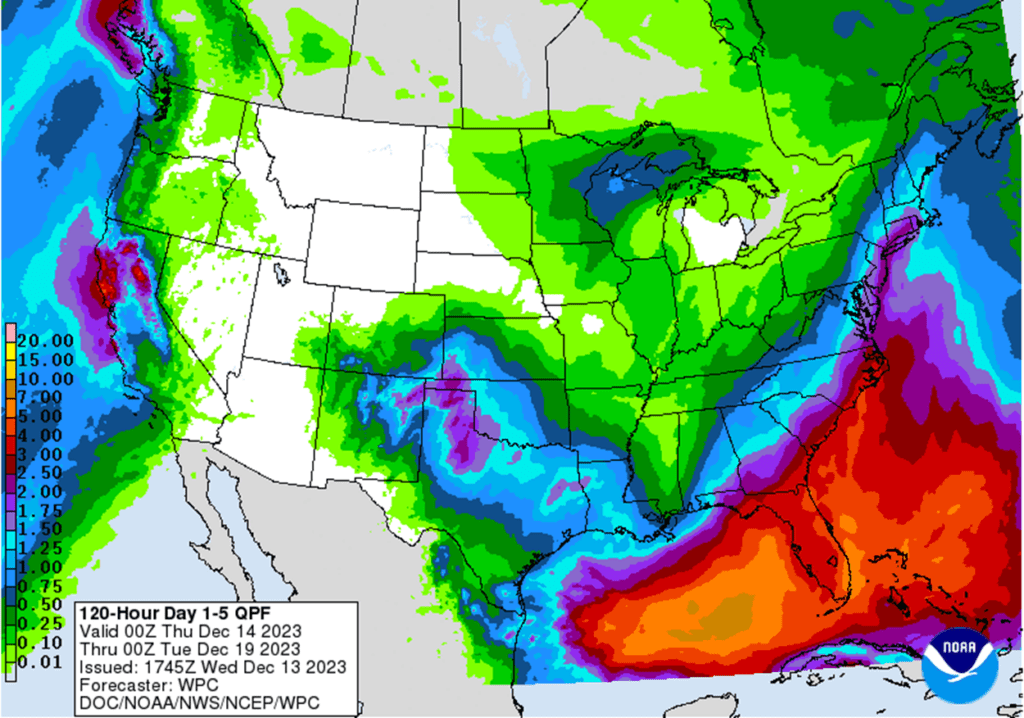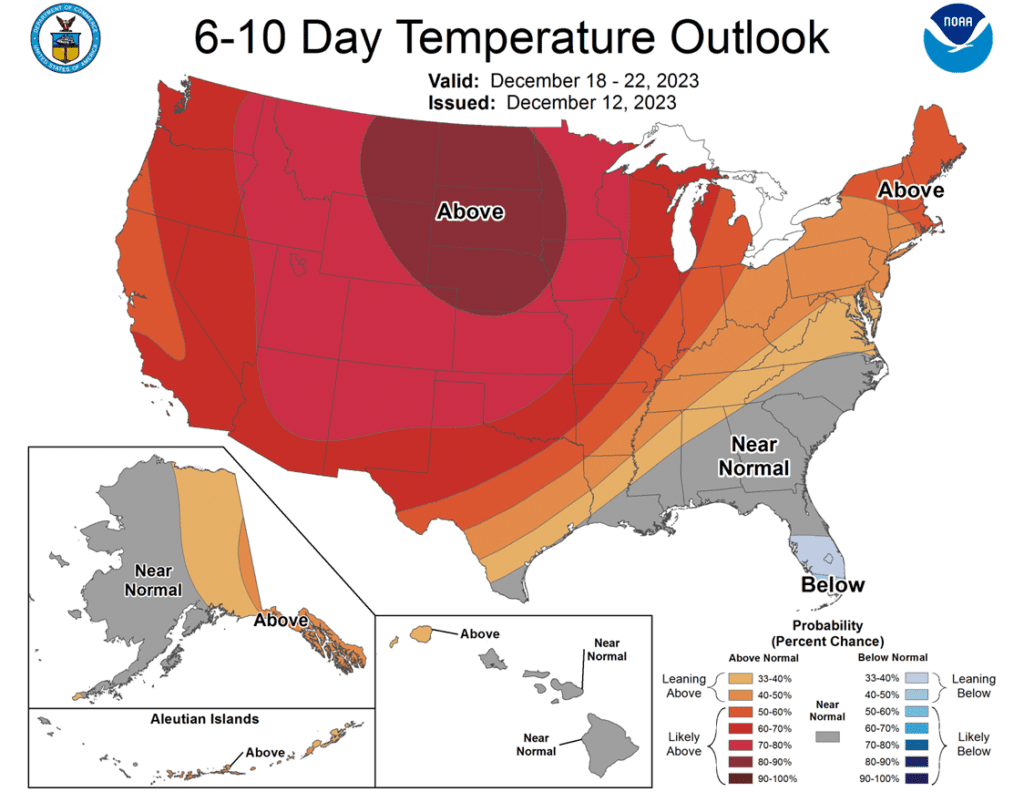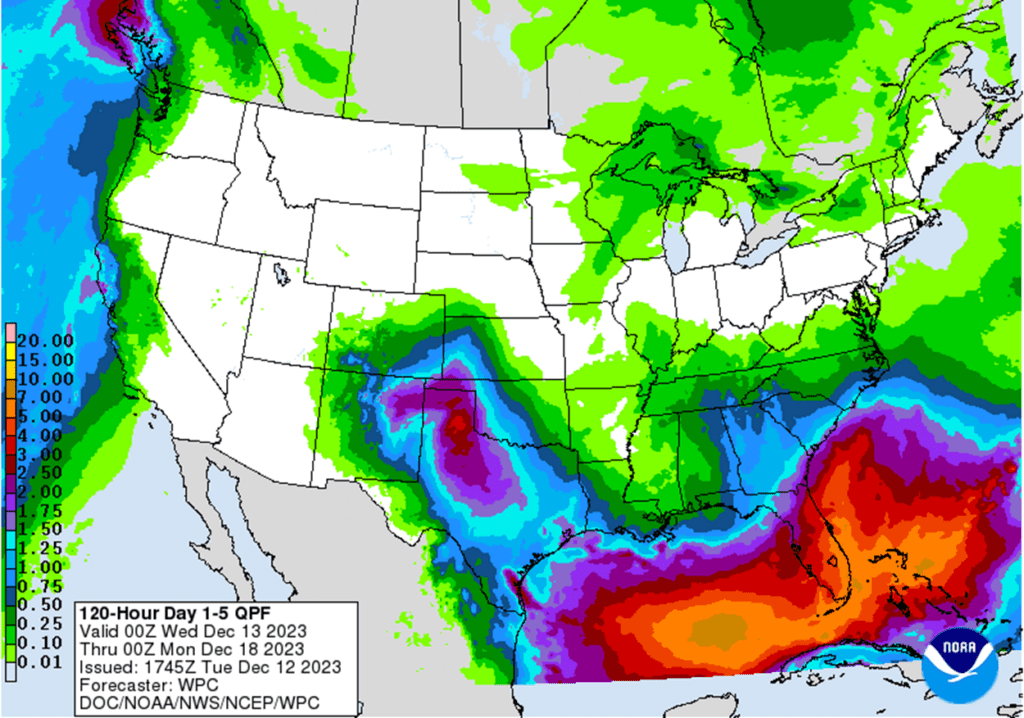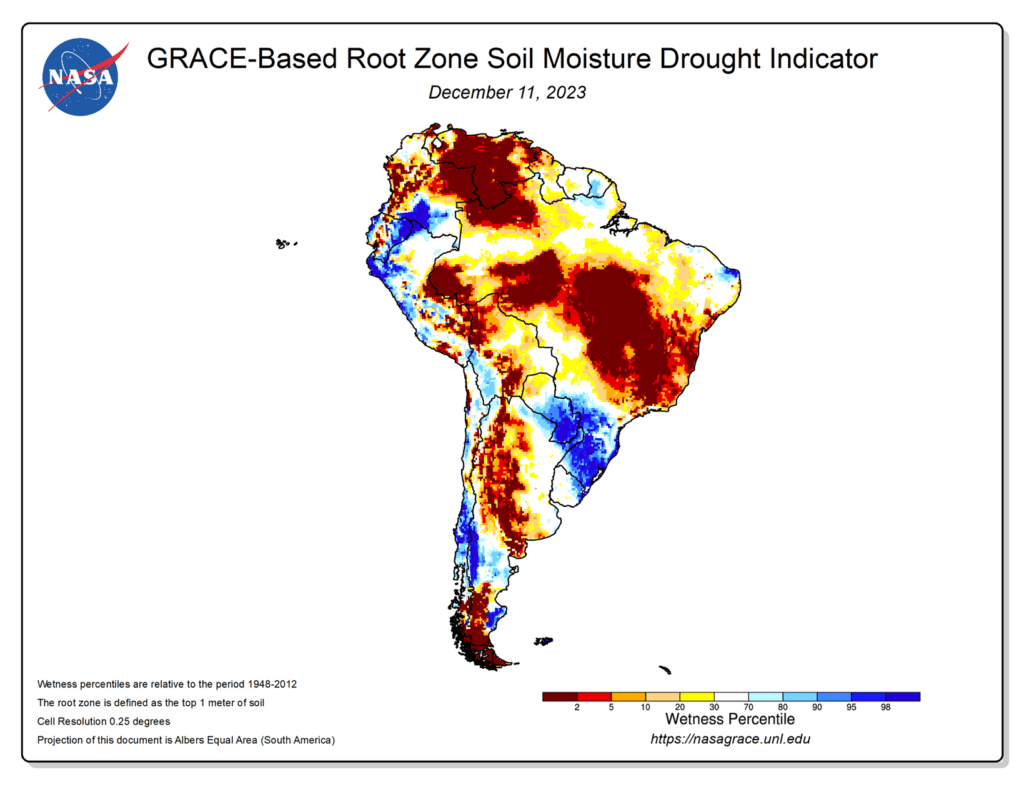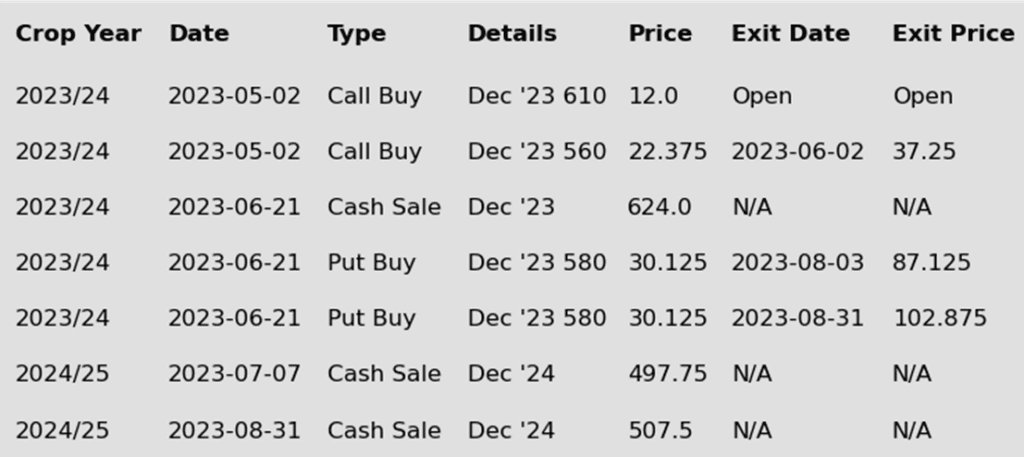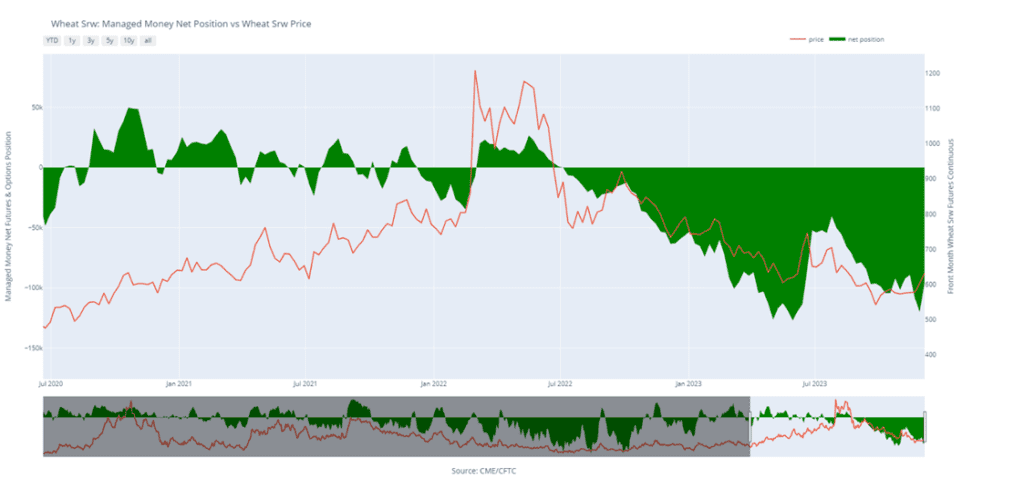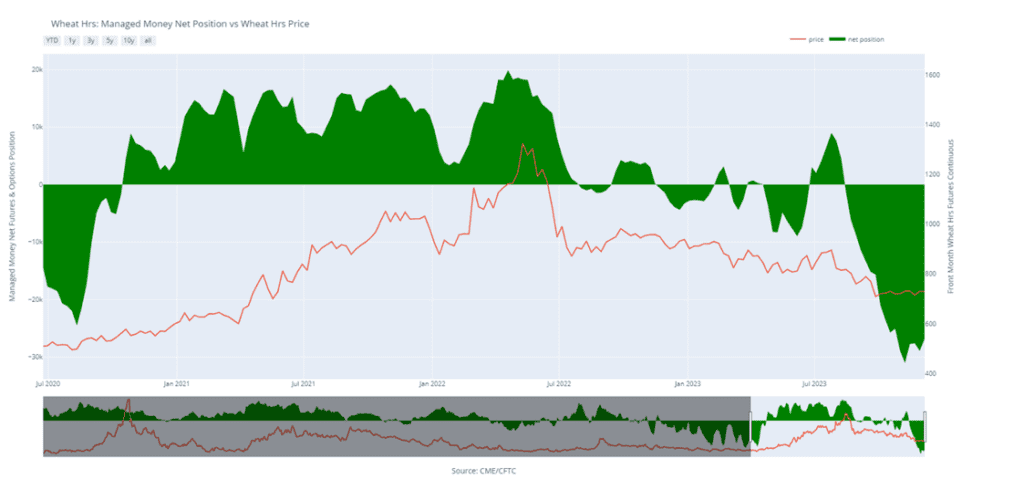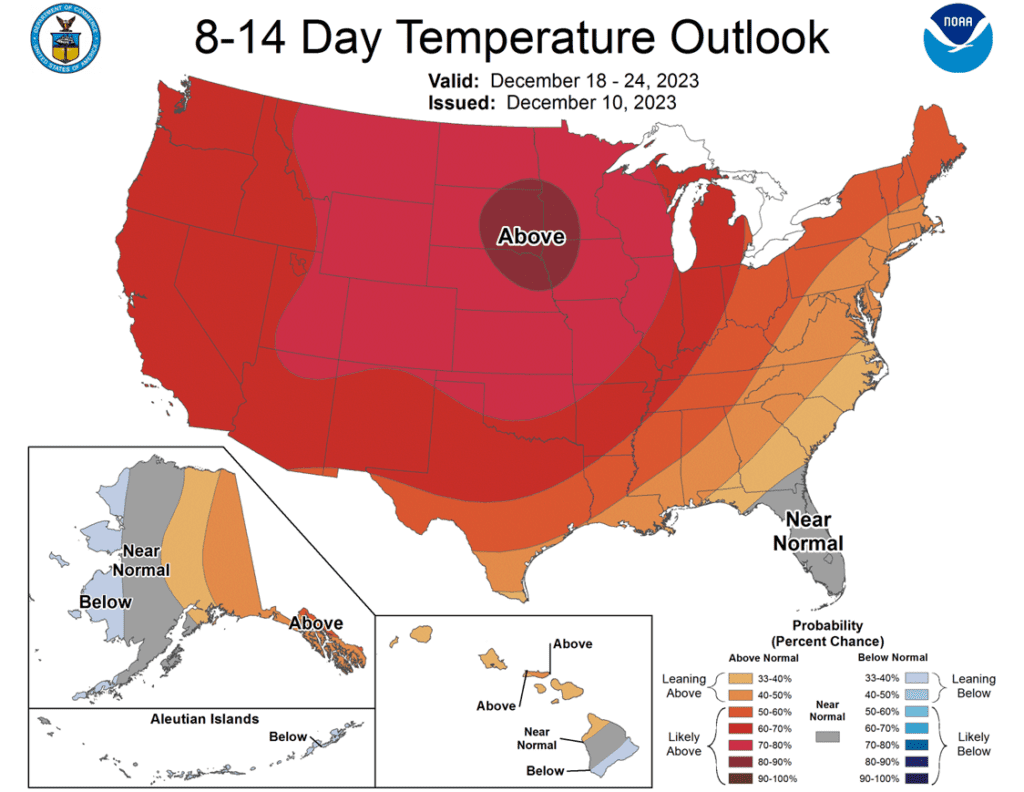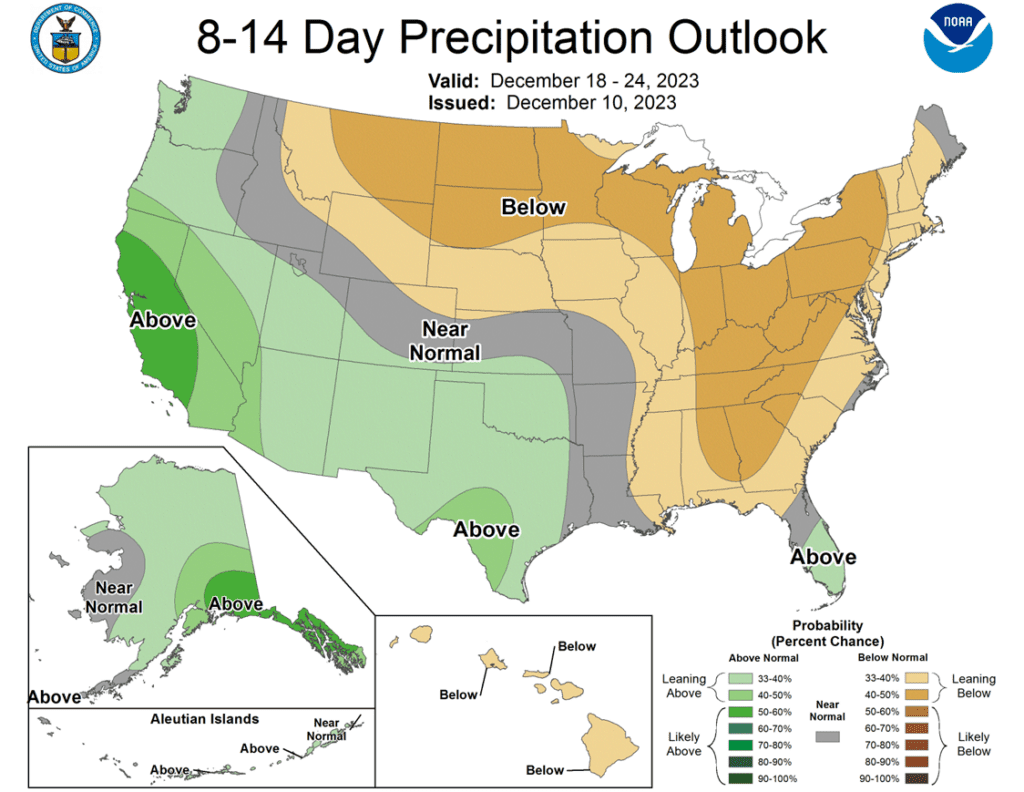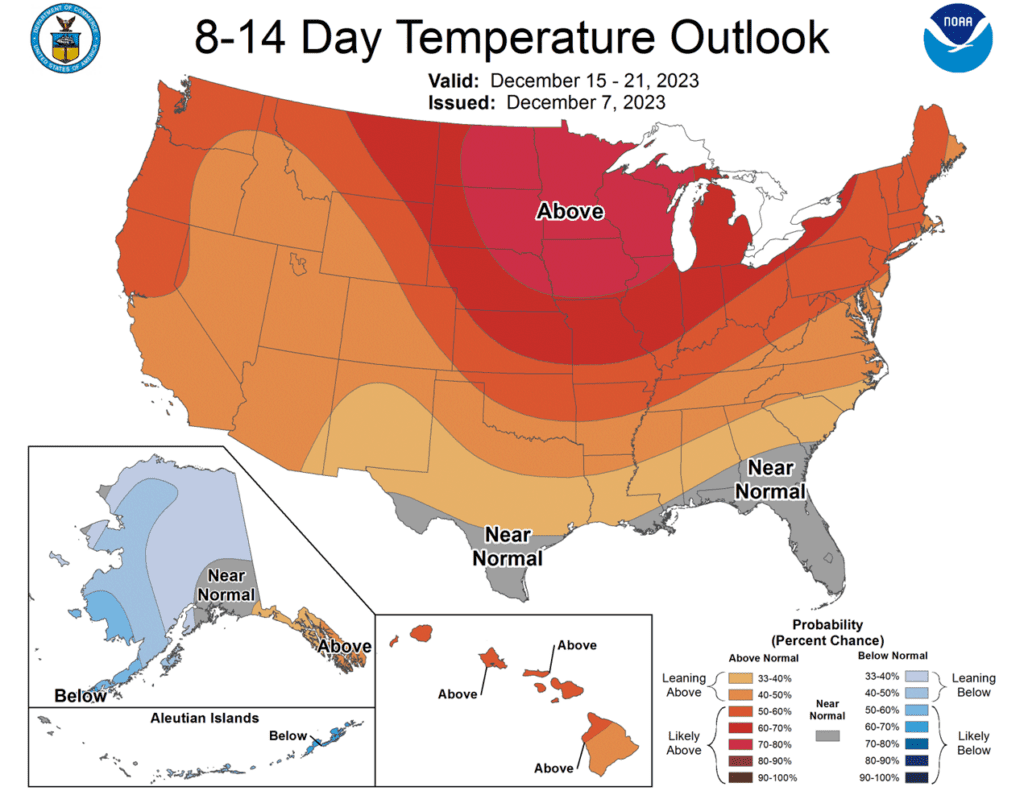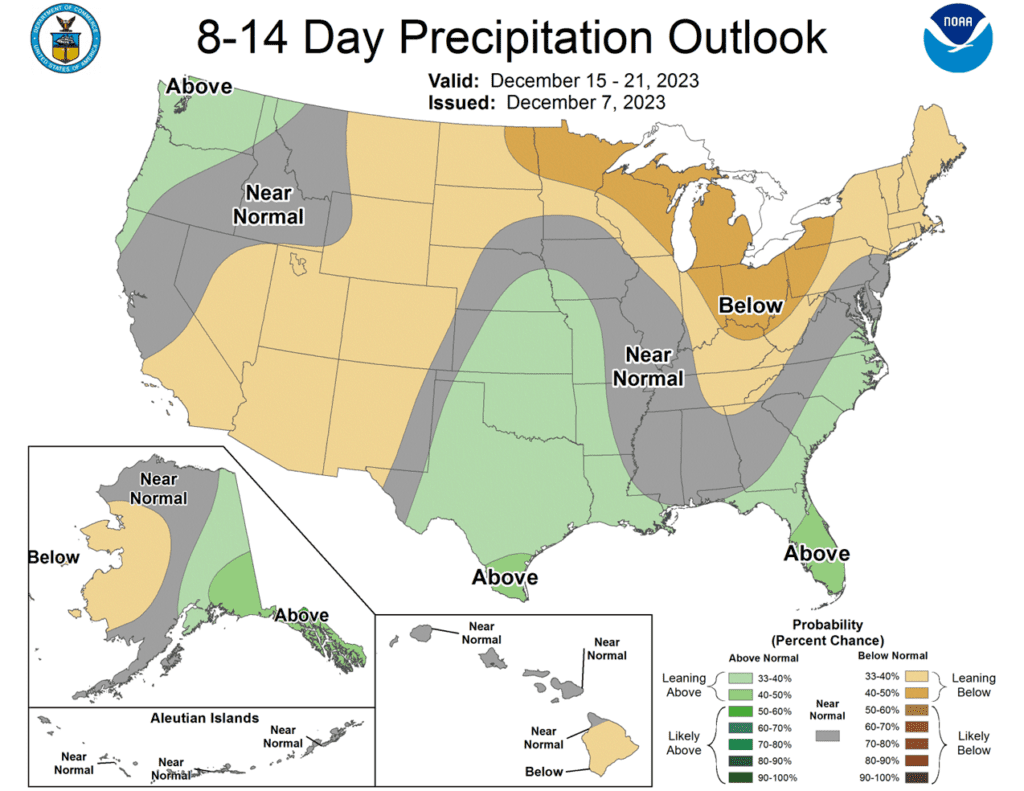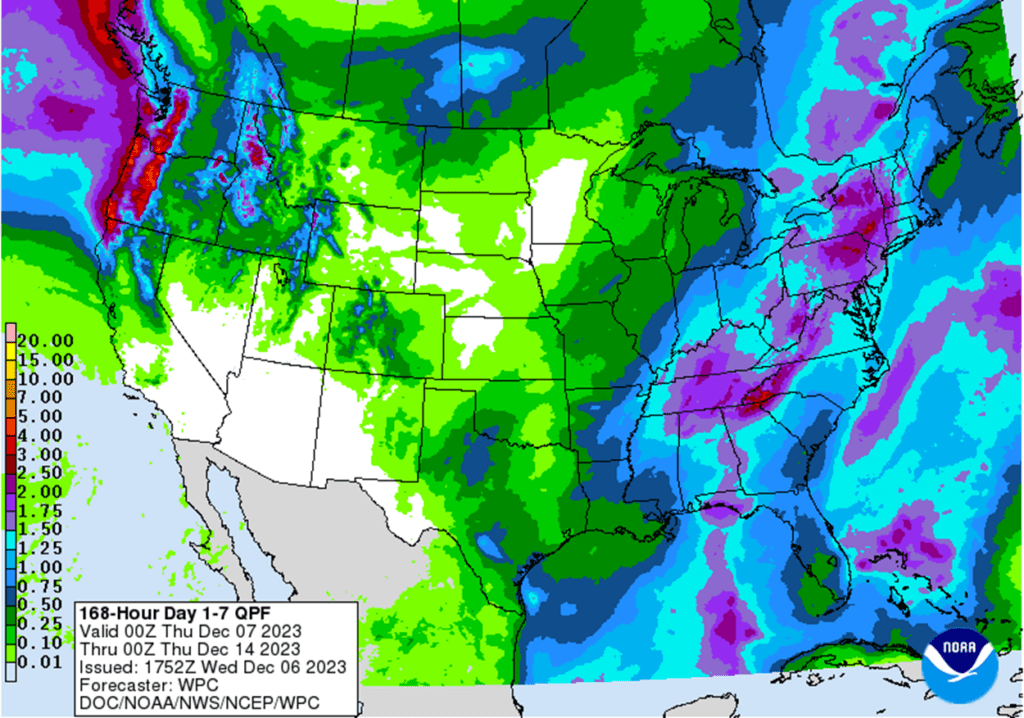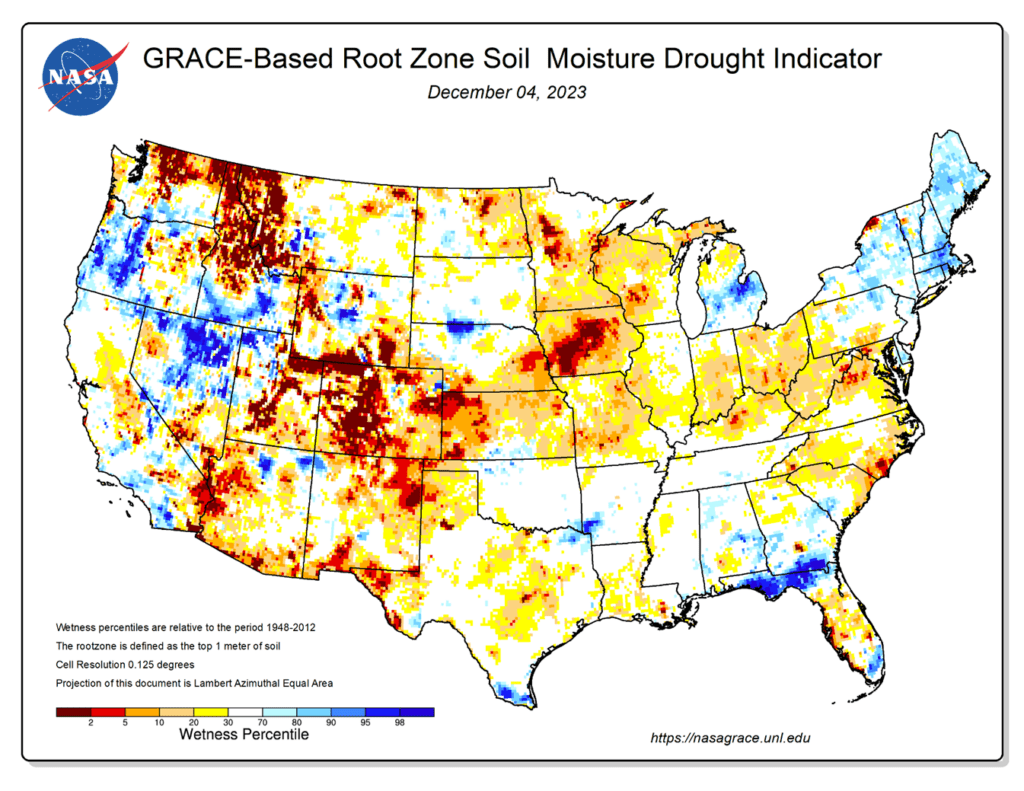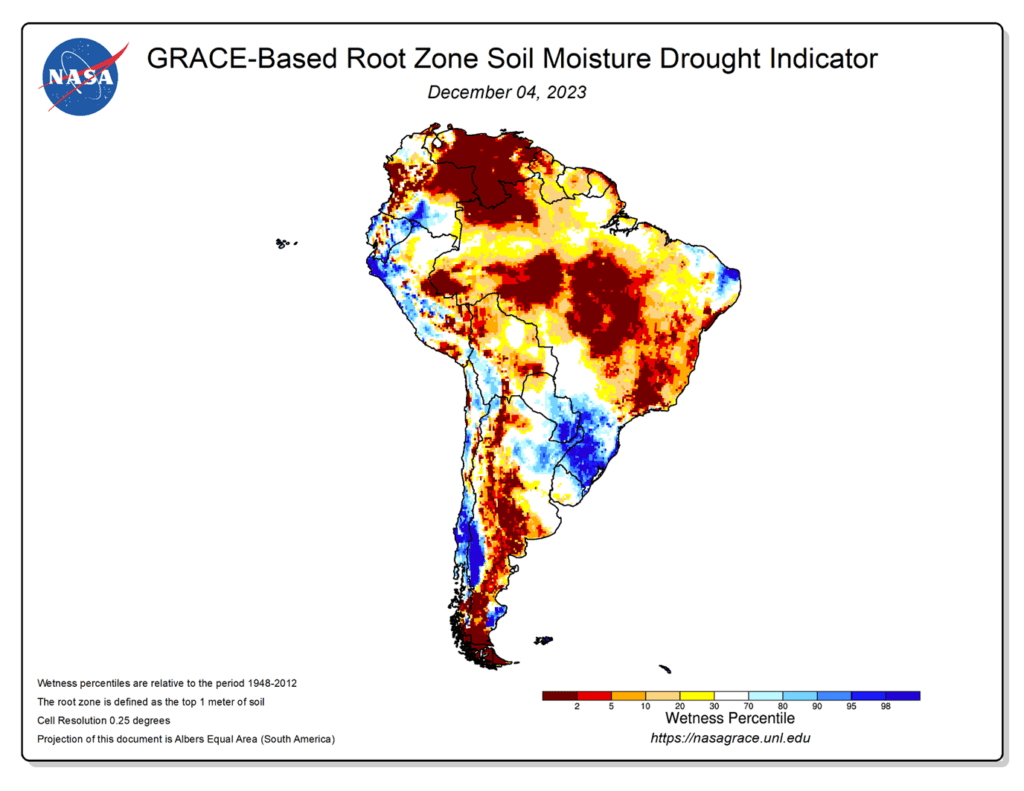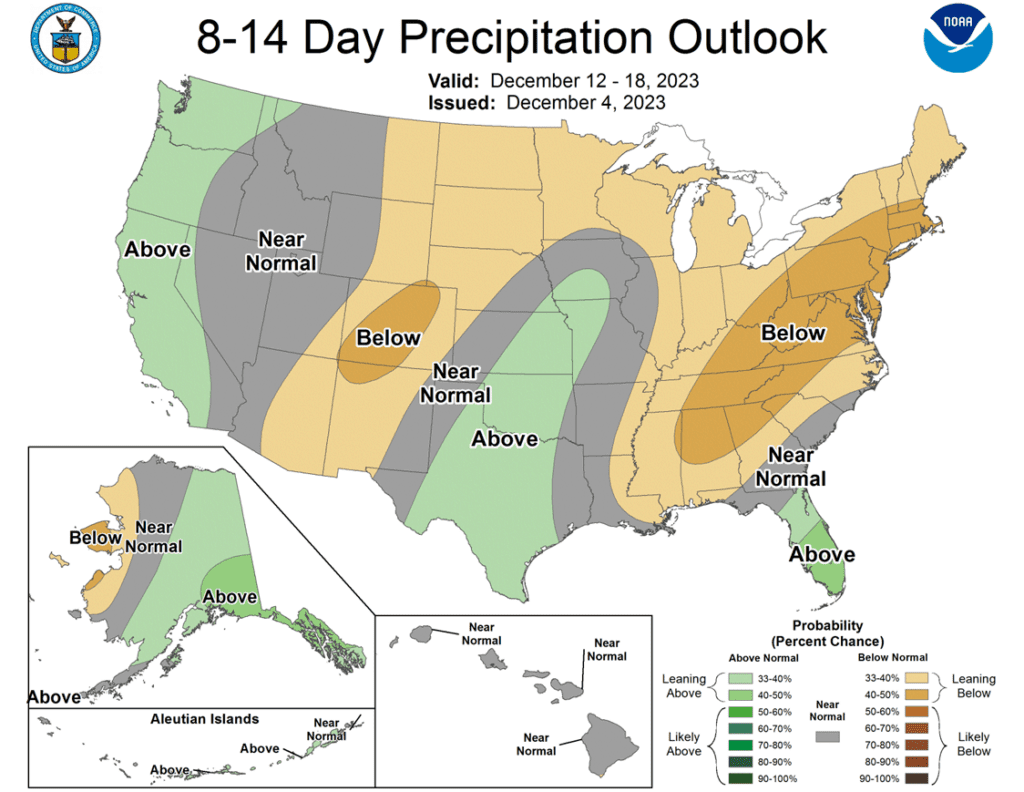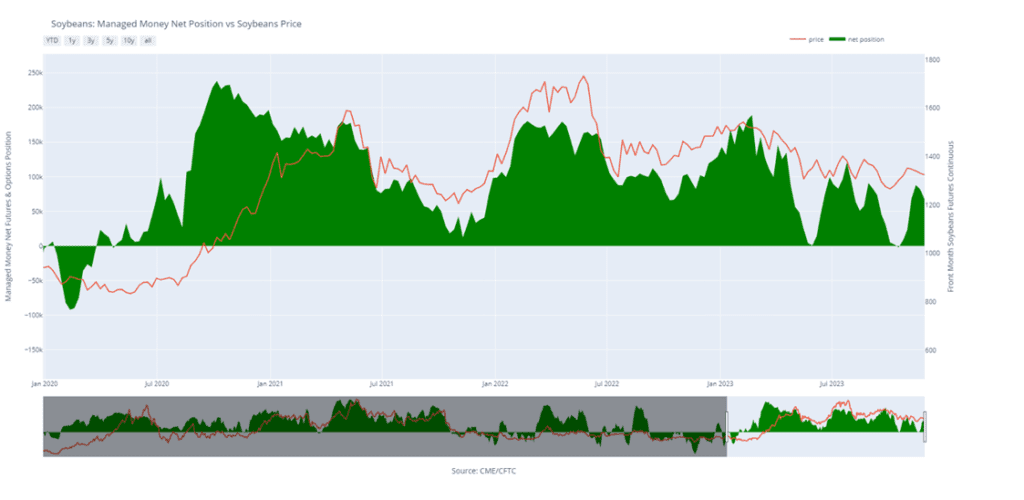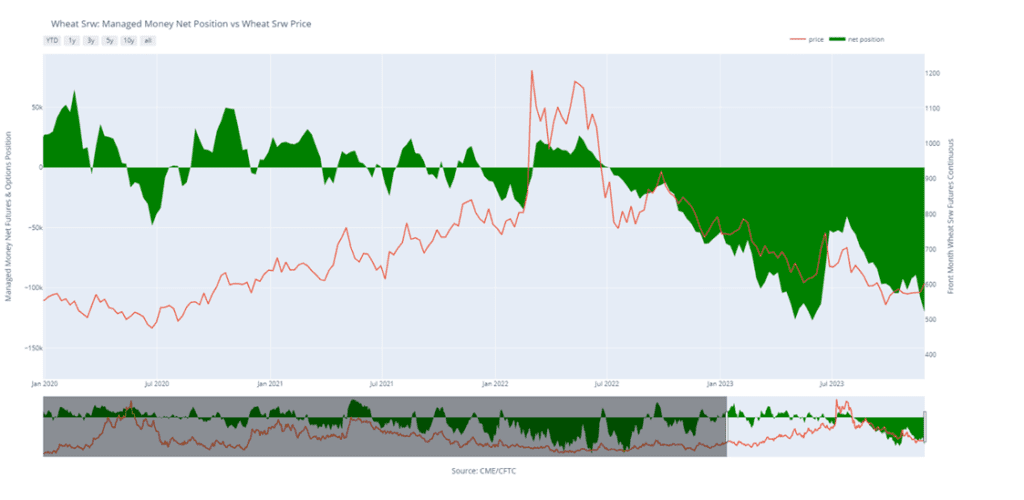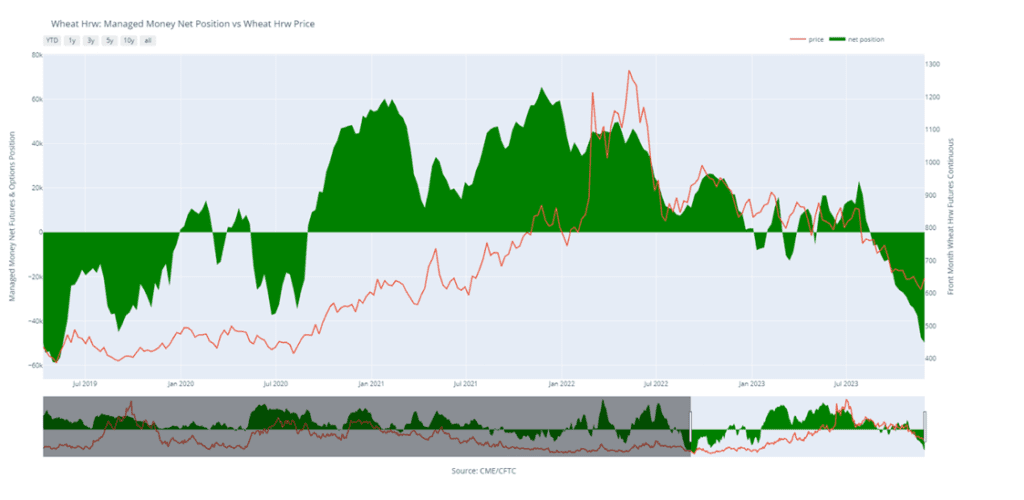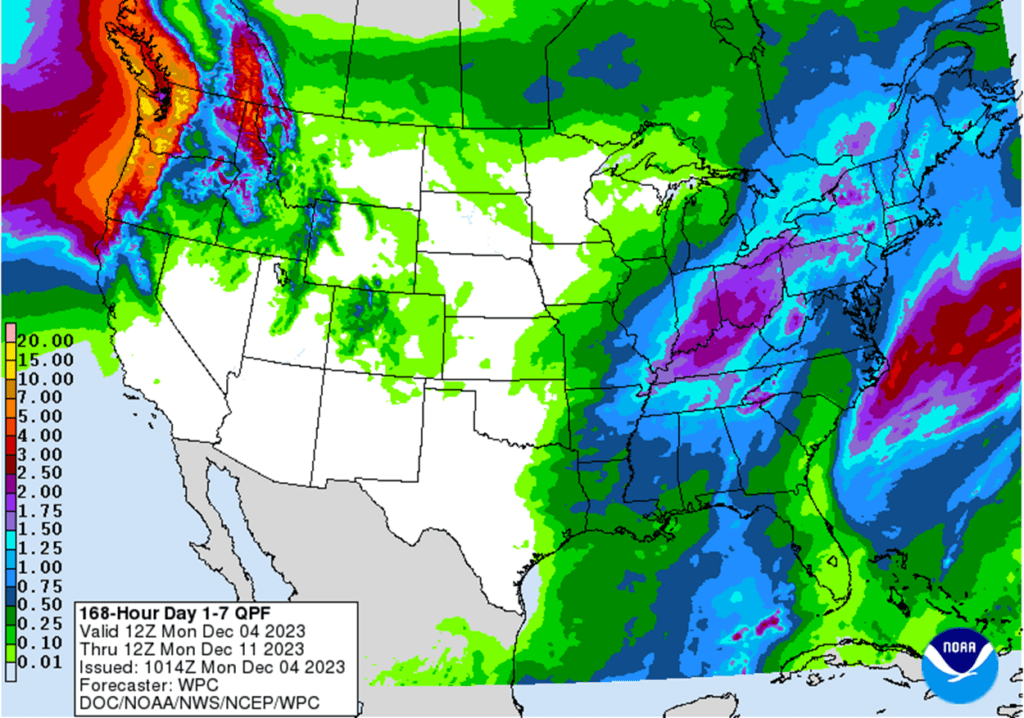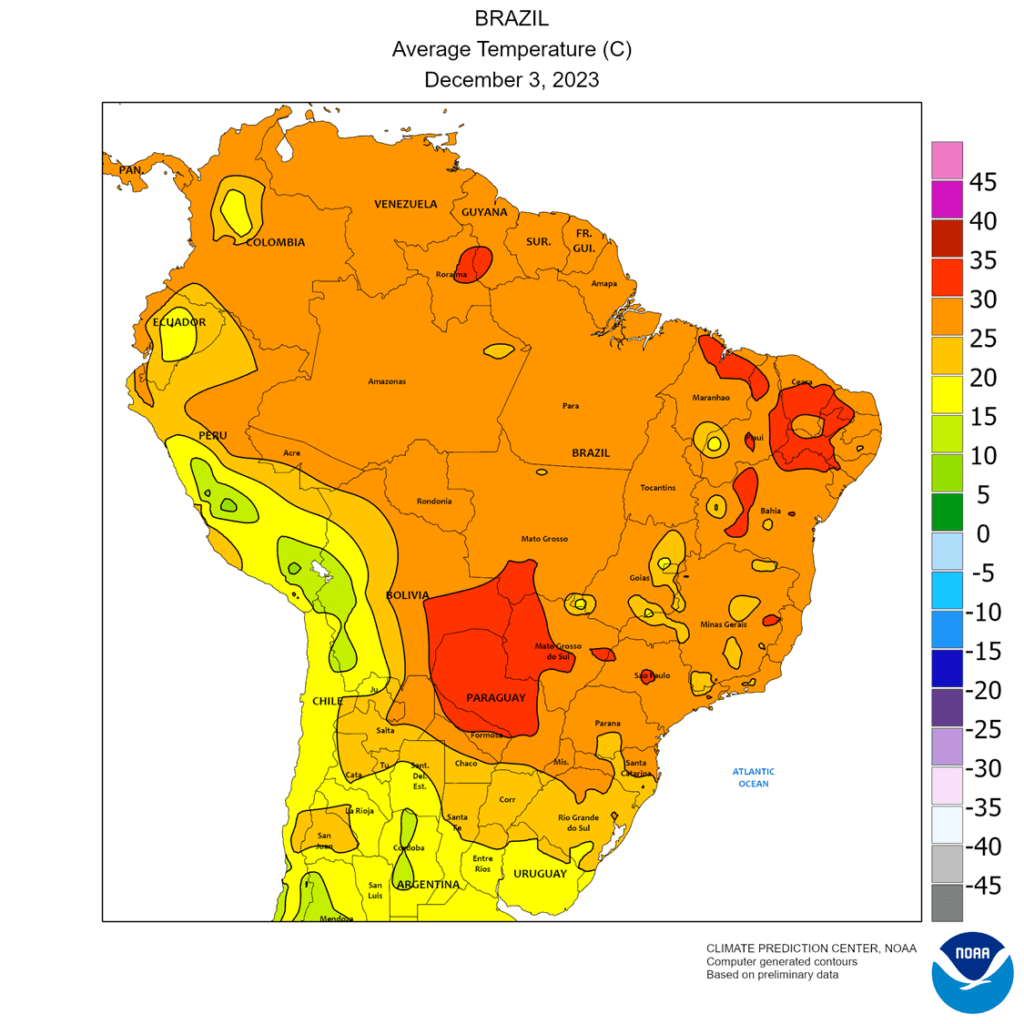12-15 End of Day: Markets Close Mostly Higher and Near the Day’s Highs
All prices as of 2:00 pm Central Time
Grain Market Highlights
- After briefly trading lower on this morning’s open, the corn market saw two-sided trade with little fresh news and closed higher on the day, on some likely position squaring ahead of the weekend.
- The USDA reported another round of private exporter sales, and near record NOPA crush numbers for November lent support to the soybean market that saw choppy two-sided to close the day mixed and well off its lows.
- Soybean meal and oil also saw choppy two sided trade and closed mostly higher, which added support to soybeans and was reflected in the 7 ¾ cent gain in January Board crush margins.
- All three wheat classes settled firmly in the green on follow-through strength from yesterday’s solid export sales that were a marketing year high and the largest since 2020.
- To see the updated US 8 – 14 day temperature and precipitation outlooks, as well as the Brazil and Argentina 2-week forecast total precipitation courtesy of the National Weather Service, scroll down to other Charts/Weather Section.
Note – For the best viewing experience, some Grain Market Insider content is best viewed with your phone held horizontally.
Corn
Corn Action Plan Summary
- No new action is recommended for 2023 corn. Since the beginning of August, the corn market has traded sideways largely between 470 and 500. October’s brief breakout to 509 ½ and the subsequent failure to stay above the 50-day moving average indicates there is significant resistance in that price range. The failure of December’s USDA report to provide a bullish influence on the market puts the market at risk of drifting sideways to lower without a bullish catalyst. During last summer’s June rally, Grain Market Insider recommended making sales when Dec ’23 was around 624. For now, Grain Market Insider will continue to hold tight on any further sales recommendations for the next few weeks with the objective of seeking out better pricing opportunities. If the market has not turned around by then, Grain Market Insider may sit tight on the next sales recommendations until spring.
- No new action is recommended for 2024 corn. Since late February ’22, Dec ’24 has been bound by 485 ¾ on the bottom and 602 on the top. After testing 491 to 547 last July, it has mostly traded between 500 and 525. During this time, Dec ’24 has held up better as bear spreading has allowed Dec ’24 to maintain more of its value versus old crop prices as traders attempt to price in a larger 2023 carryout with more uncertainty remaining for the 2024 crop. Moving forward, the risk for 2024 prices is the same as for 2023 prices, which is a continuation of a sideways to lower trend without a bullish catalyst. Grain Market Insider is watching for signs of a change in the current trend to look at recommending buying Dec ’24 call options. This past spring, Grain Market Insider recommended buying Dec ‘23 560 and 610 call options ahead of the summer rally and having those in place helped provide confidence to pull the trigger on recommending 2023 sales into that sharp rally, knowing that if corn kept rallying and went to 700 or 800 that the call options would protect those sold bushels.
- No Action is currently recommended for 2025 corn. Grain Market Insider isn’t considering any recommendations at this time for the 2025 crop that will be planted two springs from now. It will probably be late winter or early spring of 2024 before Grain Market Insider starts considering the first sales targets.
To date, Grain Market Insider has issued the following corn recommendations:
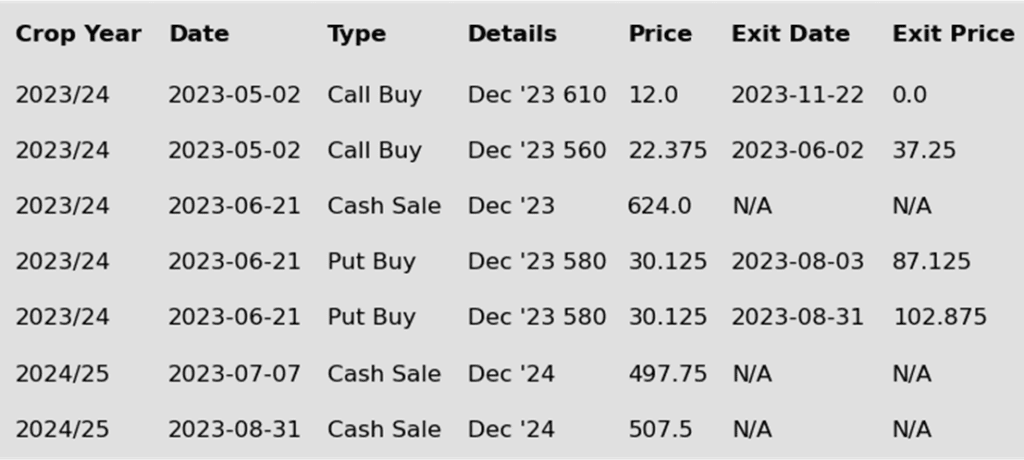
- Corn futures saw some late session buying strength to push slightly higher on the sessions. March corn added 3 ¾ cents on the days but was 2 ½ cents on the week.
- Relatively quiet news day in the corn markets as prices saw positive money flow toward the end of the session. Managed funds are still sitting in a large short position in the corn market, and likely squared some of those positions heading into the weekend.
- December corn futures expired on Thursday. The concern in the market now is the carry to the March contract. March is currently holding a 23 ¾ cent carry to December’s final closing price, and this could keep pressure on the March contract as demand concerns, and a large current supply of corn, will limit the front end of the corn market.
- Ethanol margins should see some price support with a potential turn in energy prices. Both crude oil and gasoline prices are looking to close the week with gains for the first time in 8 weeks on Friday afternoon. This could signal a potential near-term low in energy prices, which should help support the corn market if the trend turns higher.
- South American weather will remain a focus for the market. The next 7 days show a more moderating precipitation. Longer extended forecasts are more favorable for crop growth, but those forecasts will need to materialize. The South American weather concerns will likely be a longer-term corn story as Brazil looks towards soybean harvest and corn planting in the weeks ahead.

Above: Since the middle of November, the corn market has been rangebound between 470 on the downside and 497 on the upside. Upside resistance appears to be heavy given the bearish reversal that was posted on December 6. That heavy resistance also extends up to the October high of 509 ½, which the market will need more bullish influence to trade through. If the market retreats through nearby 470 support, major support remains near 460.
Soybeans
Soybeans Action Plan Summary
- Grain Market Insider sees a continued opportunity to sell a portion of your old crop 2023 soybean production. Since last summer, the soybean market has been mostly rangebound between 1435 on the topside and 1251 on the bottom. Within this range, the 1330 area has been a strong pivot point. When over 1330, the front month has been able to challenge the 1400 area, but below 1330 the front month has challenged the 1250 area. Following last Friday’s USDA update, the market has attempted to rally above 1330, but so far that rally has been rejected. This rejection poses the risk that the front month could challenge the 1250 area again. Also, given the projected record large global carryout of soybeans, Grain Market Insider wants to take advantage of the historical value of 1300+ soybean prices.
- No action is recommended for the 2024 crop. Since the inception of the Nov ’24 contract, it has traded at a discount to the 2023 crop from as much as 142 back in July, to as little as 17 ¾ in early October during harvest. While the spread difference between the two crops has seen a good amount of volatility, Nov ’24 has been largely rangebound between 1250 and 1320 since it rallied off its 1116 ¼ low last May. To date, Grain Market Insider has not recommended any sales for next year’s soybean crop. First sales targets will probably be early winter at the earliest. Currently, Grain Market Insider’s focus is also on watching for any opportunities to recommend buying call options.
- No Action is currently recommended for 2025 Soybeans. Grain Market Insider isn’t considering any recommendations at this time for the 2025 crop that will be planted two springs from now, and it may be some time before conditions are conducive to consider making any recommendations. Be patient as we monitor the markets for signs of improvement.
To date, Grain Market Insider has issued the following soybean recommendations:

- Soybeans ended the day mostly lower apart from the January contract which closed higher by a hair. Soybeans came back significantly from their lows earlier in the day, and soybean oil ended with a higher close, while meal ended higher in the two front months.
- For the week, January soybeans gained 11 ¾ cents, January meal gained just 0.90, and January soybean oil lost 0.21. Some strength came from the hot and dry conditions in Brazil this week, but rain is set to return next week. Flash sales were reported nearly every day this week, which also added support.
- This morning, the USDA reported private exporter sales of 134,000 mt of soybeans for delivery to China and 447,500 mt for delivery to unknown during the 23/24 marketing year. Just this week, 1,436,500 mt of soybean were reportedly sold with China and unknown destinations as the main buyers. At least one sale was reported each day this week.
- The NOPA crush report was released today and showed a near record crush for November at 189.038 mb, which was above the average trade guess of 187 mb and above last year’s 179 mb. Crush margins have slipped this week but remain profitable.

Above: After posting a high of 1398 ½ in November, soybeans found support around 1292. Overhead, nearby resistance remains near 1350 and again around 1400. If the market breaks support at 1292, it runs the risk of testing 1250.
Wheat
Market Notes: Wheat
- All three US wheat classes closed higher again today, despite a mixed to lower close in Paris milling wheat futures. The US March contracts all closed near session highs, despite the US Dollar’s two-sided trade, and strength into the close. Yesterday’s export sales were a marketing year high at 54.8 mb and the largest since June of 2020. Wheat may have traded higher today following through on that news. With the recent large sales to China, wheat export commitments are now up 3% versus a year ago, with the USDA forecasting a decline of 4.5%.
- On a bearish note, rain today in the US southern Plains will benefit the winter wheat crop and also help soil conditions. There are also chances for more rain over the next two weeks. While this may not have much impact currently, it may lead to improved conditions in the spring that could pressure the market.
- Now that the Federal Reserve’s policy on raising interest rates seems to have ceased, this could mean that fund money may begin to flow back into the agriculture sector. Currently, index fund holdings in the ag space are down about 35% from the peak in 2022 when the Fed began raising rates.
- Farmer groups are opposing Argentina’s move toward increasing export taxes on corn, wheat, and other ag goods, from the current 12% to 15% under the new president’s leadership. Argentina has also re-opened their grain export registry after a brief pause.
- The El Nino weather pattern is expected to intensify to one of the top levels on record. If these predictions are true, it would make this El Nino pattern one of the strongest historically since 1950. This pattern could mean a colder winter for the southern US, but milder conditions in northern regions, and far reaching impact globally. The US Climate Prediction Center is estimating a 75% chance that the pattern will persist into May.
Chicago Wheat Action Plan Summary
- No new action is currently recommended for 2023 Chicago wheat. Between late July and the end of November, front month Chicago wheat trended lower, driven mostly by weak US demand and lower world wheat prices. During that time, and as managed funds established most of their short position of nearly 120,000 contracts, the market became extremely oversold. Since then, as the market rallied to a high of 649 ½, China made several US SRW wheat purchases, and funds covered more than 23,000 short contracts. During that runup, Grain Market Insider recommended making an additional sale to take advantage of the elevated prices in case the rally was temporary since US wheat prices remain elevated relative to other world exporters, despite the increase in demand. If the market remains strong and continues to rally, Grain Market Insider will consider potential re-ownership strategies to protect current sales and add confidence to make additional sales at higher prices.
- No new action is recommended for 2024 Chicago wheat. Since July, new crop Chicago wheat has slowly worked its way lower with no significant opportunities to make additional sales. The lower market was driven mostly by managed fund selling from lower world wheat prices and weak US demand. As the market sold off, it became significantly oversold with managed funds building a short position in excess of 100,000 contracts. While bearish headwinds remain, the large fund short position and oversold condition of the market are two factors that could fuel a sizeable, short-covering rally. Additionally, price seasonals are supportive as prices tend to build in some risk premium going into the winter months. At the end of August, Grain Market Insider recommended purchasing July 590 puts to prepare for further price erosion, and back in June, Grain Market Insider recommended two separate sales that averaged about 720 to take advantage of the brief upswing. If the market receives the needed stimulus to move prices back toward this summer’s highs, Grain Market Insider is prepared to recommend adding to current sales levels and possibly even purchasing call options to protect those sales. Otherwise, the current recommended put position will add a layer of protection if prices erode further, and Grain Market Insider will be prepared to recommend covering some of those puts to offset much of the original cost and move toward a net neutral cost for the remaining position.
- No action is currently recommended for 2025 Chicago Wheat. Grain Market Insider isn’t considering any recommendations at this time for the 2025 crop that will be planted next fall. It will probably be mid-winter before Grain Market Insider starts considering the first sales targets.
To date, Grain Market Insider has issued the following Chicago wheat recommendations:


Above: After rallying to 649 ½, Chicago wheat became overbought and turned lower after the December 8 USDA report. Since then, the market has found nearby support near 600. Nearby resistance remains overhead near 650, with additional resistance between 660 and 665. If the market breaks nearby support, it may test the 50-day moving average, and then support near 556.
KC Wheat Action Plan Summary
- No new action is recommended for 2023 KC wheat crop. Since late July old crop KC wheat has been in a downtrend that has largely been driven by managed fund selling on low world wheat prices and weak US export demand. As the selloff progressed, the market became oversold, and the funds established the largest short position in three years. Even though bullish headwinds remain, these two factors have fueled the recent short-covering rally, which could extend much further if a bullish catalyst enters the market. This would also line up with the historical tendency for price appreciation as the market builds risk premium going into wintertime. Grain Market Insider’s strategy is to look for price appreciation going into this winter, as weather becomes a more prominent market mover and may consider suggesting additional sales if prices become over extended.
- No new action is recommended for 2024 KC wheat. At the end of August, the Jul ’24 contract broke out of roughly a one-year trading range, between 740 and 860, to the downside. Since that breakout, the market has continued to slowly stair-step lower, largely driven by managed fund selling, weak US export demand, and lower world wheat prices. As the selloff progressed, the funds built up the largest net short position in three years. While bearish headwinds remain, the significant oversold condition of the market and the large fund net short position are two factors that could fuel a short-covering rally in the months ahead. Price seasonals are also supportive as prices tend to build in some risk premium going into the winter months. Back in August, Grain Market Insider recommended buying Jul’24 KC wheat 660 puts to protect the downside following the range breakout. Though as the market recently got further extended into oversold territory and the July contract showed signs of support near 630, Grain Market Insider recommended exiting 75% of the originally recommended position. Moving forward, Grain Market Insider is prepared to recommend exiting the last 25% on any further supportive market developments.
- No action is currently recommended for 2025 KC Wheat. Grain Market Insider isn’t considering any recommendations at this time for the 2025 crop that will be planted next fall. It will probably be mid-winter before Insider starts considering the first sales targets.
To date, Grain Market Insider has issued the following KC recommendations:


Above: Following bearish reversals on December 6th and December 8th, the market has shown that there is significant overhead resistance above 680. The market is also showing signs of being oversold following the recent runup, which adds upward resistance and could add pressure if the market continues lower. Below the market, initial support comes in near 630, with further support remaining around 595 and 575.
Mpls Wheat Action Plan Summary
- No new action is currently recommended for the 2023 New Crop. Following last July’s rally, the market has slowly stair-stepped lower, primarily due to low world wheat prices, weak US export demand, and managed fund selling. With the funds building a record large short position as the market sold off. Since weak US export demand remains the main impediment to higher prices, the market continues to be at risk of further downside erosion. The record large fund short position could fuel a rally back higher if a bullish catalyst enters the scene, and if that happens, it may signal that a near-term low is in place. Earlier this year, Grain Market Insider made a sales recommendation during the July rally near 820, and with that sale in place, Grain Market Insider’s strategy is to look for price appreciation this winter with an eye on considering additional sales around 725 – 775, and again north of 800. If at that point the market remains strong and continues to rally, Grain Market Insider will consider potential re-ownership strategies to protect current sales and add confidence to make additional sales at higher prices.
- No new action is recommended for 2024 Minneapolis wheat. At the end of August, the Sept ’24 contract traded to a peak of 871 ¾ and has continued to slowly stair-step lower, largely driven by lower world wheat prices, weak US export demand, and managed fund selling, and as the selloff progressed, the funds built up a record large short position. While bearish headwinds remain, the significant oversold condition of the market and the large fund net short position are two factors that could fuel a short-covering rally in the months ahead. Price seasonals are also supportive as prices tend to build in some risk premium going into the winter months. Back in August, Grain Market Insider recommended buying July ’24 KC wheat 660 puts to protect the downside following a 1-year range breakout in KC wheat. Though recently, as the KC market extended further into oversold territory and the July ‘24 KC wheat contract showed signs of support near 630, Grain Market Insider recommended exiting 75% of the originally recommended position. While in the same time frame, Grain Market Insider also recommended making an additional sale as the Sept ’24 Minneapolis contract broke long time 743 support. For now, moving forward, Grain Market Insider is prepared to recommend exiting the last 25% of the open puts on any further supportive market developments.
- No action is currently recommended for the 2025 Minneapolis wheat crop. Grain Market Insider isn’t considering any recommendations at this time for the 2025 crop that will be planted two springs from now. It will probably be mid-winter before Grain Market Insider starts considering the first sales targets.
To date, Grain Market Insider has issued the following Minneapolis wheat recommendations:
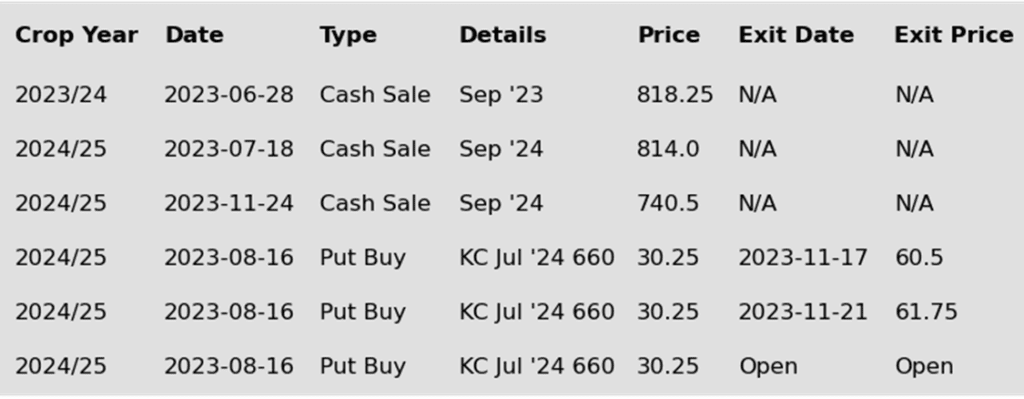

Above: After making a new contract low on November 27, the March contract found buying interest from its oversold status and record fund short. Since then, the market posted a bearish reversal on December 6, showing significant resistance in the 750 area. If prices can break through upside resistance, they could run toward 790. If prices retreat, nearby support could be found around 718, with further support near the recent low of 697 ½.
Other Charts / Weather
